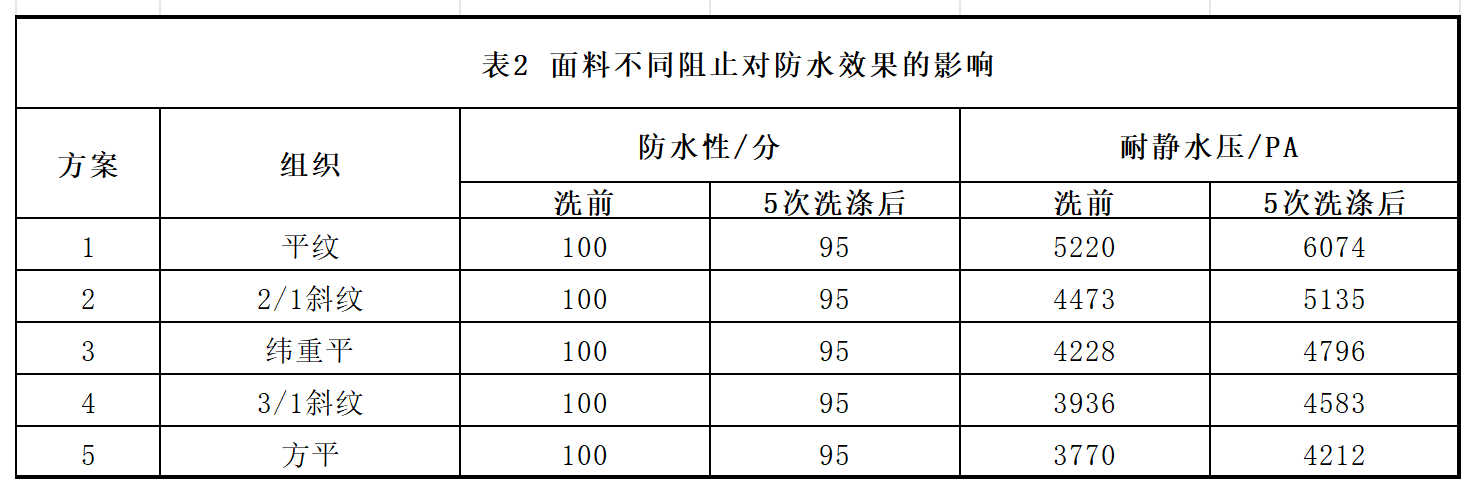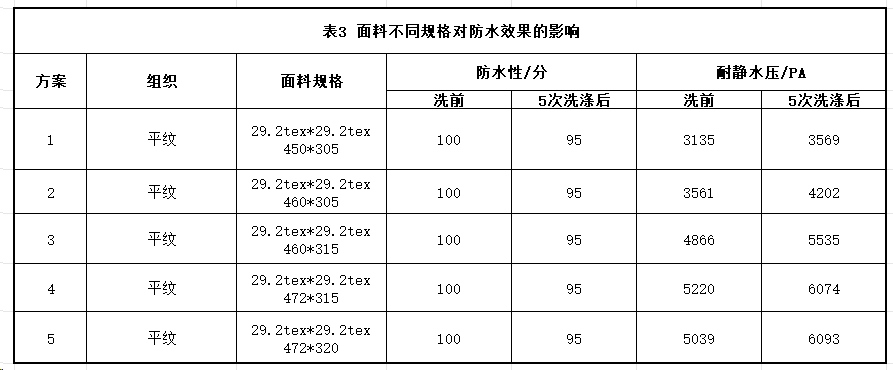In recent years, with the popularity of outdoor activities, the demand for textiles with waterproof and splash proof properties has greatly increased among consumers. The current mainstream process is to achieve waterproof and splash proof performance through coating or film finishing, but there are drawbacks such as complex process and long processing flow. Processing fluorine free waterproof finishing on high-density fabrics can achieve high resistance to static water pressure, with a short process, simple process, and the advantage of low cost; Although the static water pressure resistance performance is not as good as that of coating or laminating methods, after process optimization, the static water pressure resistance can still reach 5200Pa or above, and it has a certain degree of breathability, suitable for special functional fabrics such as surgical gowns, assault suits, mountaineering clothes, and tent fabrics.
This study selected Suzhou Leman Polymer Technology Co., Ltd. as a fluorine free waterproofing agent and used a high-temperature baking method to carry out waterproofing treatment on high-density pure cotton fabrics. The effects of factors such as tissue specifications, baking temperature, and baking time on the static water pressure resistance of pure cotton fabrics were explored, and a complete solution conducive to large-scale production was ultimately formed!
1、 Test materials
Fabric: Pure cotton fabric (29.2 tex x 29.2 tex, 472 x 315, plain weave, unit area mass 220 g/m2);
Reagent: Fluorine free waterproof agent
Instruments: Continuous shaping dryer, hot air baking machine (German Menfuji), DHG-9140A electric blast drying oven, SDLATLAS Vortex M6 washing machine, YB813 fabric moisture tester, YG461E static water pressure digital breathability meter.
2、 Process flow
Cold rolling batch → annealing → mercerization → dyeing → waterproofing → baking.
3、 Introduction to Result Testing Methods
Waterproofness: measured in accordance with AATCC 22-2010 “Water repellency: Spray test”. Cut 3 pieces (17.78 cm x 17.78 cm) of samples and place them at standard atmospheric pressure for 4 hours. Inject 250mL of distilled water at (27 ± 1) ℃ into the funnel of the tester and spray the front of the samples. Compare the wetting or spot patterns on the front with the rating image for rating, and record the rating results of each test sample.
Washability: Home washing is carried out in accordance with GB/T 8629-2017 “Household Washing and Drying Procedures for Testing Textiles”. A solution is prepared using 1g/L standard detergent (AATCC 1993), with a bath ratio of 1:30. After washing at 40 ℃ for 8 minutes, the solution is dehydrated, resulting in one wash. After the washing program is completed, dry it in an oven at a temperature of 100 ℃.
The industrial washing process is as follows: pre washing (50L of pure water, wash for 3 minutes, water temperature 50 ℃) → main washing (80L of pure water, wash for 15 minutes, water temperature 60 ℃, 300g of oxygen bleach, 400g of laundry detergent) → rinsing (50L of pure water, wash for 5 minutes) → neutralization washing (50L of pure water, 200g of neutralizing acid) → washing with clean water (50L of pure water, wash for 5 minutes).
Hydrostatic pressure resistance: measured in accordance with AATCC 127-2018 “Hydrostatic Pressure Test”. Cut three 200 mm x 200 mm non folded and contaminated samples and place them at standard atmospheric pressure for 4 hours. Control the temperature of the water in contact with the sample to (21 ± 2) ℃, dry the clamping surface, and make the test surface face the water surface. After clamping, start the motor. When there is infiltration at three positions on the sample, record the static water pressure at this time, repeat three times, and take the average value to obtain the static water pressure resistance of the sample.
4、 The influence of waterproofing process on waterproofing effect
Experimental exploration of the influence of one-step stretching and baking method and two-step stretching and baking method on waterproofing effect. In the one-step method, a stretching and shaping machine is used. After the fabric is rolled, it enters the drying room of the shaping machine, and the drying and baking processes are carried out together for high production efficiency, suitable for most waterproof finishing. The two-step method of stretching and baking uses a stretching and shaping machine to dry the rolled material, followed by baking. This process has high stability. One step process of stretching and baking: stretching machine impregnation and rolling agent, 80g/L fluorine free waterproof agent, temperature 170 ℃, time 3.5 minutes. The two-step process of stretching and baking: stretching machine immersion rolling additive (80g/L of fluorine free waterproof agent, drying temperature of 120 ℃, drying time of 60 seconds) → baking (temperature of 170 ℃, time of 3 minutes). The results of waterproofing treatment on pure cotton fabric using different waterproofing processes are shown in Table 1.
From Table 1, it can be seen that the waterproof performance of the one-step stretching and baking method is not significantly different from that of the two-step stretching and baking method, but the static water pressure resistance performance is significantly lower than that of the two-step stretching and baking method. This is because the one-step method of direct high-temperature baking, even if the vehicle speed is reduced and the penetration time of the working fluid is extended, the working fluid still cannot fully penetrate the fabric, and the fluorine free waterproof agent crosslinks on the surface of the fabric, affecting the static water pressure resistance of the fabric. Therefore, it is determined to use the two-step method of stretching and baking to process pure cotton high resistance to static water pressure fabric.
5、 The influence of different fabric organization specifications on waterproofing effect
Considering that high resistance to static water pressure fabrics are generally used for external wear and functional purposes, the mass per unit area of the fabric is limited to (200 ± 20) g/m2. The specifications are selected as pure cotton 29.2 tex x pure cotton 29.2 tex, 472 x 315, and the design organization is plain, 2/1 twill, weft weight flat, and square. Adopting a two-step processing process of stretching and baking, the waterproof working fluid is 80g/L of fluorine-free waterproof agent, with two immersion and two rolling, and a rolling residual rate of 65%; Dry at 120 ℃ and then bake at 170 ℃ for 3 minutes. The influence of different fabric structures on waterproof performance is shown in Table 2.
From Table 2, it can be seen that when the fabric yarn count and warp/weft density remain unchanged, only changing the organizational pattern results in significant changes in the fabric’s waterproofing and resistance to static water pressure. Ranked in descending order of performance excellence: plain weave, 2/1 twill, weft weight flat, 3/1 twill, and square weave. The plain weave fabric can achieve a static water pressure resistance of 5200 Pa, while other fabrics have not reached 5200 Pa. This indicates that the influence of fabric structure on static water pressure resistance is very obvious. Plain weave fabric has the best static water pressure resistance because it has the most interweaving points and fewer pores. To further investigate the relationship between organizational specifications and fabric resistance to static water pressure, the warp and weft density were changed while the yarn count and organization remained unchanged. The waterproof and static water pressure resistance of the fabric were tested separately, and the results are shown in Table 3.
From Table 3, it can be seen that for a plain weave structure of 29.2 tex x 29.2 tex, as the tissue density increases, the fabric’s resistance to static water pressure also increases accordingly. When the density reaches 472 x 315, the resistance to static water pressure is above 520 Pa. On this basis, increasing the fabric density leads to a linear increase in weaving difficulty, while the improvement in static water pressure resistance is not significant. After comprehensive consideration, plain weave fabrics of pure cotton 29.2 tex x pure cotton 29.2 tex and 472 x 315 were ultimately selected as the standard specifications for this high hydrostatic pressure resistant fabric.
6、 The influence of baking temperature and time on waterproofing effect
The baking time and baking temperature have an important impact on the waterproofing effect. The two-step processing technology of stretching → baking is adopted, with stretching machine immersion and rolling agent, fluorine free waterproofing agent 80g/L, drying temperature 120 ℃, and drying time 60 seconds. The influence of baking temperature and time on waterproofing and static water pressure resistance is studied, and the results are shown in Table 4.
From Table 4, it can be seen that as the baking temperature increases, the static water pressure resistance and waterproofing of the fabric also increase. Because during baking, the higher the temperature, the more regular the arrangement of hydrophobic groups on the fiber surface; High temperature conditions are also conducive to the release of isocyanate groups by crosslinking agents, improving the degree of crosslinking between isocyanate and hydrophobic groups and – OH, and enhancing the resistance to static water pressure. When the baking temperature is 170 ℃, continuing to increase the temperature will result in limited increase in static water pressure resistance and waterproofing. Therefore, the baking temperature was determined to be 170 ℃. Based on the above experiment, the baking temperature was determined to be 170 ℃, and the effect of baking time on waterproofing and static water pressure resistance was studied. The results are shown in Table 5.
From Table 5, it can be seen that as the baking time prolongs, the waterproofing performance continuously improves. This is because the baking time prolongs, and the crosslinking between isocyanate groups and hydrophobic groups on the fiber surface is more complete. Long term baking also provides sufficient time for the ordered arrangement of hydrophobic groups on the fiber surface. When the baking time is 3 minutes, the waterproof performance reaches 100 points and the resistance to static water pressure reaches 5200Pa or above; Continuing to extend the time, the improvement in waterproofing and static water pressure resistance is limited. Therefore, the baking time was determined to be 3 minutes.
7、 Conclusion
(1) Research has been conducted on the formula of waterproof working fluid. After sufficient baking, the pure cotton fabric can withstand static water pressure up to 5200Pa and has good washing resistance. Even after 30 water washes under household washing conditions, it still has excellent resistance to static water pressure and waterproofing.
(2) The stretching → baking process is as follows: stretching machine immersion rolling additive (80g/L of fluorine free waterproof agent, drying temperature of 120 ℃, drying time of 60 seconds) → baking (temperature of 170 ℃, time of 3 minutes).
Post time: Jun-26-2024






